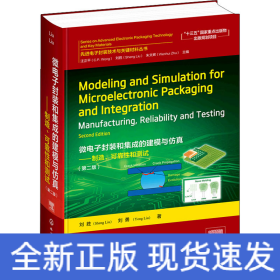
微电子封装和集成的建模与仿真——制造、可靠性和测试(第2版)
全新正版 极速发货
¥ 339.86 6.8折 ¥ 498 全新
库存4件
广东广州
认证卖家担保交易快速发货售后保障
作者刘胜,刘勇
出版社化学工业出版社
ISBN9787122392275
出版时间2021-12
装帧精装
开本16开
定价498元
货号1202603219
上书时间2024-07-02
- 最新上架
商品详情
- 品相描述:全新
- 商品描述
-
目录
Foreword by Jianbin Luo xv
Foreword by C. P. Wong xvii
Foreword by Zhigang Suo xix
Preface to Second Edition xxi
Preface to First Edition xxiii
Acknowledgments xxv
About the Authors xxvii
Part I Mechanics and Modeling 1
1 Constitutive Models and Finite Element Method 3
1.1 Constitutive Models for Typical Materials 3
1.1.1 Linear Elasticity 3
1.1.2 Elastic-Visco-Plasticity 5
1.2 Finite Element Method 9
1.2.1 Basic Finite Element Equations 9
1.2.2 Nonlinear Solution Methods 12
1.2.3 Advanced Modeling Techniques in Finite Element Analysis 14
1.2.4 Finite Element Applications in Semiconductor Packaging Modeling 17
1.3 Chapter Summary 18
References 19
2 Material and Structural Testing for Small Samples 21
2.1 Material Testing for Solder Joints 21
2.1.1 Specimens 21
2.1.2 A Thermo-Mechanical Fatigue Tester 23
2.1.3 Tensile Test 24
2.1.4 Creep Test 26
2.1.5 Fatigue Test 31
2.2 Scale Effect of Packaging Materials 32
2.2.1 Specimens 33
2.2.2 Experimental Results and Discussions 34
2.2.3 Thin Film Scale Dependence for Polymer Thin Films 39
2.3 Two-Ball Joint Specimen Fatigue Testing 41
2.4 Chapter Summary 41
References 43
3 Constitutive and User-Supplied Subroutines for Solders Considering Damage Evolution 45
3.1 Constitutive Model for Tin-Lead Solder Joint 45
3.1.1 Model Formulation 45
3.1.2 Determination of Material Constants 47
3.1.3 Model Prediction 49
3.2 Visco-Elastic-Plastic Properties and Constitutive Modeling of Underfills 50
3.2.1 Constitutive Modeling of Underfills 50
3.2.2 Identification of Material Constants 55
3.2.3 Model Verification and Prediction 55
3.3 A Damage Coupling Framework of Unified Viscoplasticity for the Fatigue of Solder Alloys 56
3.3.1 Damage Coupling Thermodynamic Framework 56
3.3.2 Large Deformation Formulation 62
3.3.3 Identification of the Material Parameters 63
3.3.4 Creep Damage 66
3.4 User-Supplied Subroutines for Solders Considering Damage Evolution 67
3.4.1 Return-Mapping Algorithm and FEA Implementation 67
3.4.2 Advanced Features of the Implementation 69
3.4.3 Applications of the Methodology 71
3.5 Chapter Summary 76
References 76
4 Accelerated Fatigue Life Assessment Approaches for Solders in Packages 79
4.1 Life Prediction Methodology 79
4.1.1 Strain-Based Approach 80
4.1.2 Energy-Based Approach 82
4.1.3 Fracture Mechanics-Based Approach 82
4.2 Accelerated Testing Methodology 82
4.2.1 Failure Modes via Accelerated Testing Bounds 83
4.2.2 Isothermal Fatigue via Thermal Fatigue 83
4.3 Constitutive Modeling Methodology 83
4.3.1 Separated Modeling via Unified Modeling 83
4.3.2 Viscoplasticity with Damage Evolution 84
4.4 Solder Joint Reliability via FEA 84
4.4.1 Life Prediction of Ford Joint Specimen 84
4.4.2 Accelerated Testing: Insights from Life Prediction 87
4.4.3 Fatigue Life Prediction of a PQFP Package 91
4.5 Life Prediction of Flip-Chip Packages 93
4.5.1 Fatigue Life Prediction with and without Underfill 93
4.5.2 Life Prediction of Flip-Chips without Underfill via Unified and Separated Constitutive Modeling 95
4.5.3 Life Prediction of Flip-Chips under Accelerated Testing 96
4.6 Chapter Summary 99
References 99
5 Multi-Physics and Multi-Scale Modeling 103
5.1 Multi-Physics Modeling 103
5.1.1 Direct-Coupled Analysis 103
5.1.2 Sequential Coupling 104
5.2 Multi-Scale Modeling 106
5.3 Chapter Summary 107
References 108
6 Modeling Validation Tools 109
6.1 Structural Mechanics Analysis 109
6.2 Requirements of Experimental Methods for Structural Mechanics Analysis 111
6.3 Whole Field Optical Techniques 112
6.4 Thermal Strains Measurements Using Moire Interferometry 113
6.4.1 Thermal Strains in a Plastic Ball Grid Array (PBGA) Interconnection 113
6.4.2 Real-Time Thermal Deformation Measurements Using Moire Interferometry 116
6.5 In-Situ Measurements on. Micro-Machined Sensors 116
6.5.1 Micro-Machined Membrane Structure in a Chemical Sensor 116
6.5.2 In-Situ Measurement Using Twyman-Green Interferometry 118
6.5.3 Membrane Deformations due to Power Cycles 118
6.6 Real-Time Measurements Using Speckle Interferometry 119
6.7 Image Processing and Computer Aided Optical Techniques 120
6.7.1 Image ftocessing for Fringe Analysis 120
6.7.2 Phase Shifting Technique for Increasing Displacement Resolution 120
6.8 Real-Time Thermal-Mechanical Loading Tools 123
6.8.1 Micro-Mechanical Testing 123
6.8.2 Environmental Chamber 124
6.9 Warpage Measurement Using PM-SM System 124
6.9.1 Shadow Moire and Project Moire Setup 125
6.9.2 Warpage Measurement of a BGA, TXvo Crowded PCBs 127
6.10 Chapter Summary 131
References 131
7 Application of Fracture Mechanics 135
7.1 Fundamental of Fracture Mechanics 135
7.1.1 Energy Release Rate 136
7.1.2 J Integral 138
7.1.3 Interfa Crack 139
7.2 Bulk Material Cracks in Electronic Packages 141
7.2.1 Background 141
7.2.2 Crack Propagation in Ceramic/Adhesive/Glass System 142
7.2.3 Results 146
7.3 Interfa Fracture Toughness 148
7.3.1 Background 148
7.3.2 Interfa Fracture Toughness of Flip-Chip Package 0between Passivated Silicon Chip and Underfill 150
7.4 Three-Dimensional Energy Release Rate Calculation 159
7.4.1 Fracture Analysis 160
7.4.2 Results and Comparison 160
7.5 Chapter Summary 165
References 165
8 Concurrent Engineering for Microelectronics 169
8.1 Design Optimization 169
8.2 New Developments and Trends in Integrated Design Tools 179
8.3 Chapter Summary 183
References 183
Part II Modeling in Microelectronic Packaging and Assembly 185
9 Typical IC Packaging and Assembly Processes 187
9.1 Wafer Process and Thinning 188
9.1.1 Wafer Process Stress Models 188
9.1.2 Thin Film Deposition 189
9.1.3 Backside Grind for Thinning 191
9.2 Die Pick Up 193
9.3 Die Attach 198
9.3.1 Material Constitutive Relations 200
9.3.2 Modeling and Numerical Strategies 201
9.3.3 FEA Simulation Result of Flip-Chip Attach 204
9.4 Wire Bonding 206
9.4.1 Assumption, Material Properties and Method of Analysis 207
9.4.2 Wire Bonding Process with Different Parameters 208
9.4.3 Impact of Ultrasonic Amplitude 210
9.4.4 Impact of Ultrasonic Frequency 212
9.4.5 Impact of Friction Coefficients between Bond Pad and FAB 214
9.4.6 Impact of Different Bond Pad Thickness 217
9.4.7 Impact of Different Bond Pad Structures 217
9.4.8 Modeling Results and Discussion for Cooling Substrate Temperature after Wire Bonding 221
9.5 Molding 223
9.5.1 Molding Flow Simulation 223
9.5.2 Curing Stress Model 230
9.5.3 Molding Ejection and Clamping Simulation 236
9.6 Leadframe Forming/Singulation 241
9.6.1 Euler Forward versus Backward Solution Method 242
9.6.2 Punch Process Setup 242
9.6.3 Punch Simulation by ANSYS Implicit 244
9.6.4 Punch Simulation by LS-DYNA 246
9.6.5 Experimental Data 248
9.7 Chapter Summary 252
References 252
10 Opto Packaging and Assembly 255
10.1 Silicon Substrate Based Opto Package Assembly 255
10.1.1 State of the Technology 255
10.1.2 Monte Carlo Simulation of Bonding/Soldering Process 256
10.1.3 Effect of Matching Fluid 256
10.1.4 Effect of the Encapsulation 258
10.2 Welding of a Pump Laser Module 258
10.2.1 Module Description 258
10.2.2 Module Packaging Process Flow 258
10.2.3 Radiation Heat Transfer Modeling for Hermetic Sealing Process 259
10.2.4 Two-Dimensional FEA Modeling for Hermetic Sealing 260
10.2.5 Cavity Radiation Analyses Results and Discussions 262
10.3 Chapter Summary 264
References 264
内容摘要
随着电子封装的发展,电子封装已从传统的四个主要功能(电源系统、信号分布及传递、散热与机械保护)扩展为六个功能,即增加了DFX及系统测试两个新的功能。其中DFX是为“X”而设计,X包括:可制造性、可靠性、可维护性、成本,甚至六西格玛。DFX有望在产品设计阶段实现工艺窗口的确定、可靠性评估和测试结构及参数的设计等功能,真正做到“第一次就能成功”,从而将计算机辅助工程(CAE)变为计算机工程(CE),以大大加速产品的上市速度。本书是全面介绍DFX在封装中应用的图书。作为封装工艺过程和快速可靠性评估及测试建模仿真的第一本专著,书中包含两位作者在工业界二十多年的丰富经验,以及在MEMS、IC和LED封装部分成功的实例,希望能给国内同行起到抛砖引玉的作用。同时,读者将会从书中的优选工程设计和微电子产品的并行工程和协同设计方法中受益。
本书第2版新增了两位作者在电子制造和封装领域新的成果与经验,例如电力电子模块的建模和仿真、电子封装耐热性的分析模型、3D TSV封装等内容。
本书主要读者对象为学习DFX(制造工艺设计、测试设计、可靠性设计等)的研究人员、工程师和学生等。
主编推荐
发展电子封装产业是摆脱西方对我国集成电路垄断的重要突破口。我国电子封装产业核心技术缺乏,工艺与装备被发达国家垄断,产业发展面临工艺、装备知识产权“空心化”局面,“卡脖子”风险凸显,严重制约我国电子制造业发展,威胁国家信息安全。国家连续四个五年计划列为重点突破课题。 为满足业内需求,作者结合自己三十年的封装经验和模拟仿真的积累,参考靠前上前沿研究成果,撰写了一本针对微电子封装的工艺制造、可靠性、测试的建模仿真的图书。本书中90%内容为作者长期的研究成果。
1. 本书是全面讲述优选微电子封装集成制造、可靠性、测试的建模和仿真的图书。修订版中增加了如下微电子封装业内热点问题,为解决靠前电子封装面临共性难题提供理论基础:
(1)跌落可靠性仿真中埋入式测试芯片验证内容。
(2)基于硅通孔叠层封装工艺及可靠性分析。
(3)电力电子封装热管理设计。
(4)第三代半导体薄膜材料生产分子动力学仿真。
2. 本书对于微电子封装与集成的关键技术——电、光、湿及热管理技术、高可靠性保证进行了详细的阐述。
3.本书关注微电子封装业内热点及难点,为解决靠前电子封装面临共性问题提供思路。
4.本书所提出的用于微电子器件优选工程设计的并行工程方法与协同设计方法,将会使广大读者受益匪浅。
— 没有更多了 —












以下为对购买帮助不大的评价